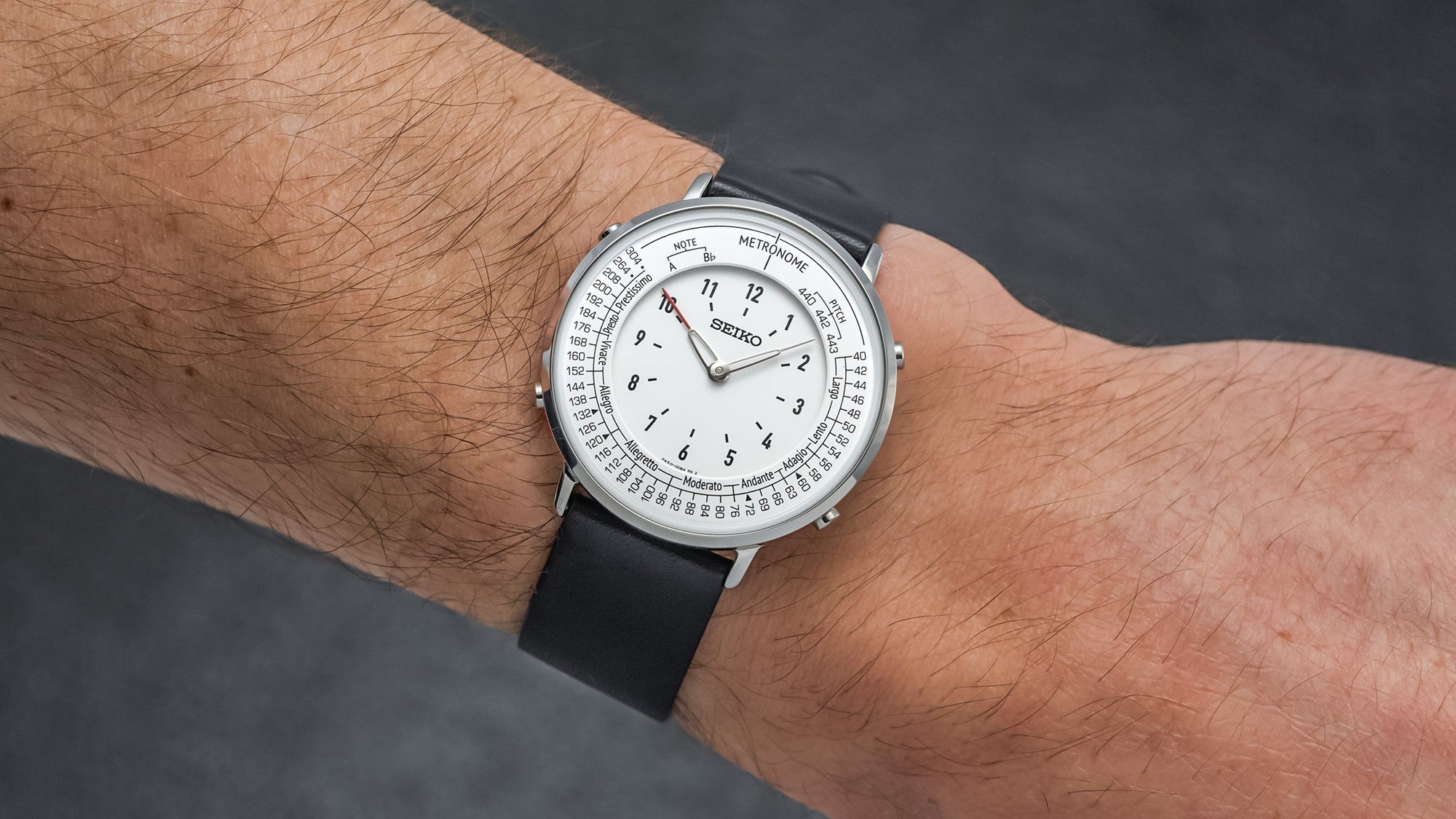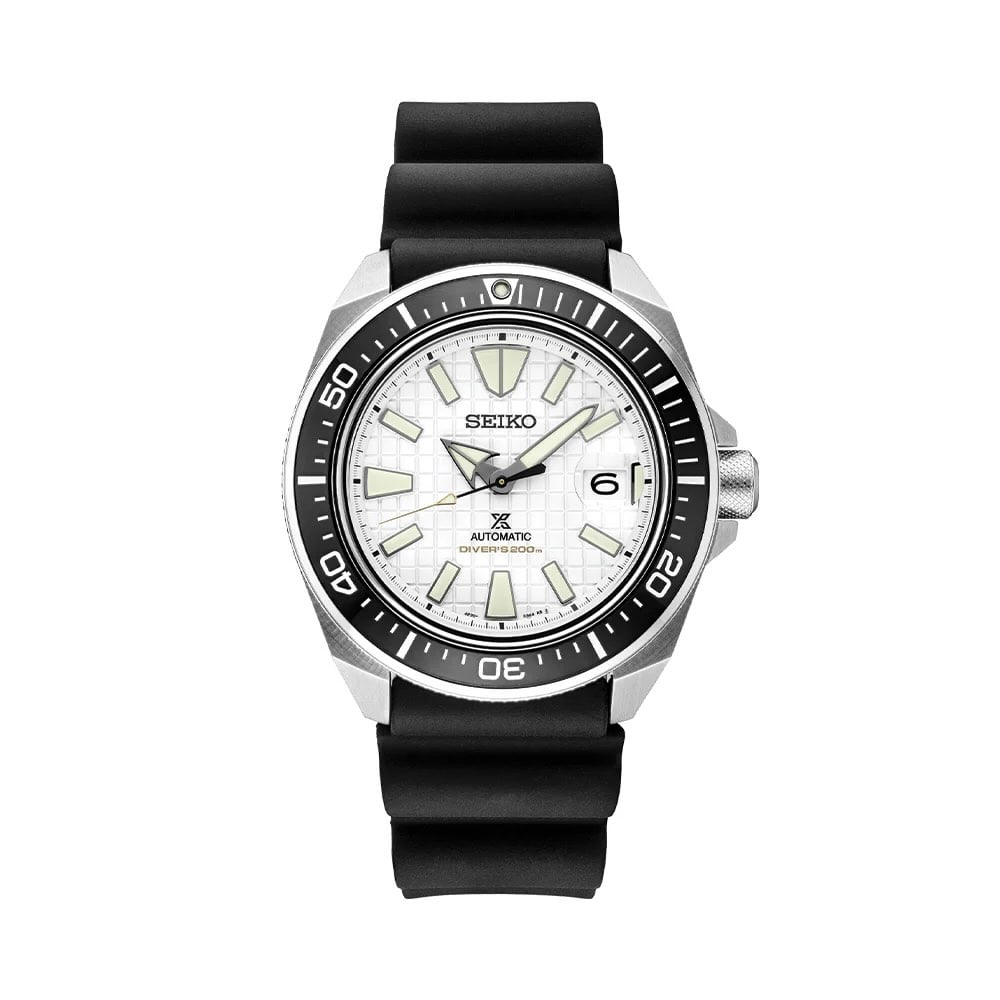I love when Seiko gets niche, quirky, or just straight-up weird. There was the Egg-Boiling watch for, well, boiling eggs. And then there was even a “Vampire-Exclusive” watch for those who choose to live that lifestyle. But the Seiko Metronome from 2022 is special because it really has a practical purpose and is a little extra nifty because it was made by Seiko Instruments, which is the brand’s division responsible for electric components, printers, and — you guessed it — metronomes. There were several versions of the watch produced in different colors but the Seiko Metronome SMW006A seen here is definitely one of the cleaner and better-looking models. A basic primer for those unfamiliar with this instrument: a metronome is a device that creates a steady beat (either audibly or visually) measured by BPM (Beats Per Minute) to help musicians stay on rhythm.
Design:

Before getting into the functionality and novelty of the Seiko Metronome, I want to talk about how well designed it is. It would be easy to relegate this watch into the "technical instrument" bucket that so often leads to the “function over form” thinking that results in such obscure and, for lack of a better word, “nerdy” designs that can be really quite off-putting. The Seiko Metronome, and more specifically the reference SMW006A, avoids falling into that trap by leaning into a minimalist, almost-Bauhaus design that belies the data-heavy display of its functionality.

The matte white dial is arranged with an inner central dial that is set up like a traditional watch dial, while the raised outer ring has all the dense metronome functions neatly arranged. By leaving the center of the dial clean, with no extraneous text or markings, the outer ring is able to communicate a lot of information without creating an overall “busy” impression. The simple black font for all the text and numerals against the matte white dial is basic elegance done properly. Given the set of tasks the hands have to perform, they are legible and attractive — while having a real sense of personality with those quasi-syringe-shaped, skeletonized oblong bases and long tips. The design challenge presented here is that the two hands need to be evenly sized so the stouter- based, red-tipped hour hand does a good enough job of distinguishing itself. Obviously, it’s not as easy to read as a typical dial, which would have a shorter hour and longer minutes hand, but that is kind of the entire point here.
Functionality:

So, how exactly does the Seiko Metronome work? First, note the four pushers on the case at 2, 4, 8, and 10 o’clock. Let’s start with establishing that time-mode is the default setting for the Seiko Metronome. Engaging the pusher at 8 o’clock starts the metronome mode, at which point the hands jump to 10 and 2 o’clock, after which the minutes hand begins its pendulum-like rhythmic motion steadily bouncing between 10 and 2 o’clock. Adjusted via the pushers at 2 and 4 o’clock, the hour hand indicates what speed the metronome is set at: it ranges from 40 bpm, which is denoted at 2 o’clock, and goes all the way to 304 bpm, denoted at 10 o’clock. These beat rates are also grouped by their corresponding Italianate musical terms like Largo, Moderato, Allegro, etc. Finally, while you’re in metronome mode, the 10 o’clock pusher activates the sound mode that is synced to the minute hand.

While you’re in metronome mode, engaging the 8 o’clock pusher changes the watch to now be in “reference tone mode,” which is used when tuning one’s instrument. While in this mode, the 10 o’clock pusher activates or deactivates the audible tone while the 2 and 4 o’clock pushers adjust the reference notes between A or B flat and 440, 442, and 443 Hz.
Movement:

The Seiko Metronome uses a basic quartz movement that is accurate to -15 seconds/month for the time function, +-2% for the metronome, and +-1 % for the reference tone function. It uses a CR2016 lithium battery that should last you about two years and costs maybe 75 cents. If you forget to change the mode back to default, the watch goes back to time mode after seven minutes of inactivity in reference time mode, or three minutes in metronome mode, which is useful in preserving battery life.
Case:

The Seiko Metronome is a humble watch, all things considered. The polished steel case measures 36.5mm wide and 9.8mm thick with a lug-to-lug height of 39.5mm that makes the watch wear on the smaller side. The bezel is slim enough to basically be non-existent and the pushers don’t protrude enough to jab the wrist or create any discomfort, which is certainly a design win. The snap-on caseback is very utilitarian, as it simply reads “METRONOME” and several lines of basic information (including the “Made In China” disclosure).
As you’d guess, this is not a water-resistant watch in any practical way. It can survive the accidental splash here and there, but you are cautioned against even running water directly over the watch. And you definitely should not press any of the pushers while the watch is wet. Finally, there is the leather strap with 18mm lug width. Frankly, this is not the best quality strap out there and feels a little synthetic. But, we are talking about a watch that retails for less than $200, so expectations should be tempered here.

Conclusion:
As far as I can tell, there really have not been any other metronome watches produced at any scale in recent history. This obviously makes sense given just how niche the user base for such a product is, even at such an accessible price point. Interestingly, there is a Patek Philippe metronome pocket watch that dates back to circa 1880 that actually doesn’t tell the time at all. It’s a fascinating little bit of history that you can learn more about from Collectability here.
The Seiko Metronome SMW006A that you see here has a simple white dial with black strap, but there were at least nine other iterations produced that are either in the “standard line,” with reference numbers ending with A (like the one seen here) or the “casual line,” with reference numbers ending with B, which have some added pizzaz like a playful font and a sort of gradient dotted outer circumference that gets denser with the bpm. The standard line models are: the SMW002A with white dial and rose gold tones on the case and dial including the hands (the hour hand here seems to be steel tipped); the SMW003A, with a silver dial with gold toned hands, numerals, and case; the SMW004A, with dark blue dial and a black case (this one looks like it has brushed hands and a polished hour hand tip to help differentiate from the minutes hand); the SMW005A, with a turquoise dial with a soft gold-colored case and steel hands with red-tipped hour hand; and the SMW006A seen here. The casual line consists of: the SMW001B, with a white dial with black dotting around the circumference and a dark-tipped hour hand; the SMW002B, with a dark pink-and-white dial with gold tones and a white-tipped hour hand; the SMW003B, with a purple-and-silver dial with gold tones and purple-tipped hour hand; and the SMW004B, with a light blue-and-white dial with light blue-tipped hour hand.

The target market for the Seiko Metronome would be the part of a Venn diagram that overlaps between watch enthusiast and musician — which is probably not a huge number when you also factor in the fact that this was a JDM (Japanese Domestic Market) release. Also, there are seemingly a few options for good metronome apps for either smartphone or wearables. The retail price of the Seiko Metronome was about 26,400 JPY which comes out to just around $185 in the U.S.. That is in line with the few listings I found on Chrono24 ranging from $160 - $215 and the many listings I found on eBay, which range between $175-240.






















































0 Comments